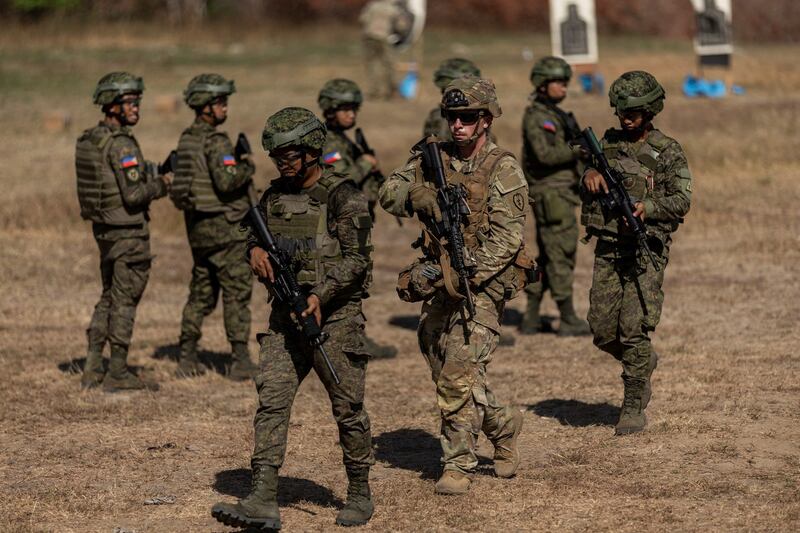The U.S. Army’s deployment of a mid-range missile launcher in the Philippines earlier this month is expected to help Manila prepare to defend its territories amid geopolitical tension over the South China Sea, security analysts said.
It’s the first time the United States has deployed the Mid-Range Capability (MRC) missile system – also known as the Typhon System – in the Asia-Pacific region, but it was not immediately clear whether the Americans would keep this easily transportable system in the northern Philippines only as part of joint military drills or for longer.
The MRC is a land-based, ground-launched system that can fire the Standard Missile 6 and Tomahawk missiles and support strike capabilities from land to sea to air, according to the U.S. Congressional Research Service.
The system was deployed on April 11 as part of Salaknib, a military drill for 1,800 Philippine and 1,700 U.S. troops that ran from April 8 to 21 in the central and northern regions of Luzon island.
The deployment is “an example of the continuous transformation of the U.S. Army in the face of a complex and challenging environment,” said Gen. Charles Flynn, commanding general of U.S. Army Pacific, said in a statement in response to emailed questions from BenarNews, a online news organization that is affiliated with Radio Free Asia.
The move “supports a safe, stable, and secure Indo-Pacific in partnership with our allies from the Armed Forces (of the) Philippines,” he said.
Officials at the U.S. Army Pacific command in Hawaii did not immediately respond to follow-up questions from BenarNews seeking more details about the deployment of the missile system in the Philippines. The Philippine military also declined to provide details, deferring to U.S. Army officials for comment.
The deployment came amid a worsening maritime row between Manila and Beijing over the South China Sea.

Salaknib ("shield" in Filipino), is an annual drill between the two nations but it is much smaller than the Balikatan, a multilateral military exercise involving at least 16,000 troops that began in the Philippines on April 22 and is scheduled to end on May 18.
“The first deployment of this state-of-the-art missile system in the Salaknib exercises will boost the interoperability and jointness of the Philippines’ armed forces with its military ally,” said Chester Cabalza, a security strategist and founding president of Manila-based think-tank International Development and Security Cooperation. “This is an opportunity also for Manila to invest in high-caliber military materiel to increase its deterrent force amid geopolitical tension in the region.”
“The MRC has a versatile capability that has been used in the multi-domain attacks in the Russo-Ukraine and Hamas-Israel wars for land-based protection of territories,” Cabalza told BenarNews. “The MRC is a strong weapon but it has limitations since its capability is mid-range for launcher missiles.”

Security analyst Ray Powell said the missile deployment was part of efforts to boost Manila's defense mechanisms amid the ongoing South China Sea dispute. Powell is founder and director of SeaLight, a maritime transparency project of the Gordian Knot Center for National Security Innovation at Stanford University.
“If you’re having a military exercise, then what you have to exercise is the military,” Powell told BenarNews.
“If you’re going to have one in the Philippines, the things that you’re going to be concerned with is one of the things that threaten the Philippines and what are the things that can defend the Philippines against those threats. These missiles are clearly in that category.”
‘Philippines shouldn’t be held back’
Previously, security analysts had raised concerns that China could ramp up its militarization activities in the South China Sea following the deployment of the missile launcher.
“With or without the MRC, China has been active in militarizing the region,” Cabalza said. “This is part of (Beijing’s) own military agenda to attain greatness in the world’s military history as it tries to control the entirety of the South China Sea.”
Lately, tensions between two countries have occurred in South China Sea waters within the Philippines’ exclusive economic zone, where Chinese coast guard ships have fired water cannons at Filipino boats trying to deliver supplies to a Philippine military outpost in Second Thomas Shoal (Ayungin Shoal).

Powell also raised concerns about Beijing.
“If China feels hurt or provoked, that’s because China is the one who is acting so aggressively,” Powell said.
“China is going to do what it wants to do. So, the Philippines shouldn’t be held back by what might provoke China … because you know what provokes an aggressor? Weakness. If they perceived weakness, that is extremely provocative to an aggressor nation. Make no mistake, especially in the South China Sea – China is an aggressor nation and it will take advantage of whatever weakness it perceives.”
China, Russia react
Last week, China and Russia hit back at America’s missile deployment in the Philippines.
"The U.S.'s move exacerbates tensions in the region and increases the risk of misjudgment and miscalculation," Chinese Foreign Ministry Spokesman Lin Jian told reporters in Beijing during an April 18 news conference. "The Philippines needs to think twice about being a cat's paw for the U.S. at the expense of its own security interests, and stop sliding down the wrong path," he said.
On Telegram, Anatoly Antonov, Russia’s ambassador to Washington, said the move was another blow to global stability.
Washington is “purposefully escalating the level of military confrontation and fueling hotbeds of tension,” Antonov said on April 17, while accusing the U.S. of “trying to return the world to the darkest times of the Cold War and balancing on the brink of a nuclear conflict.”
BenarNews is an RFA-affiliated online news organization.
